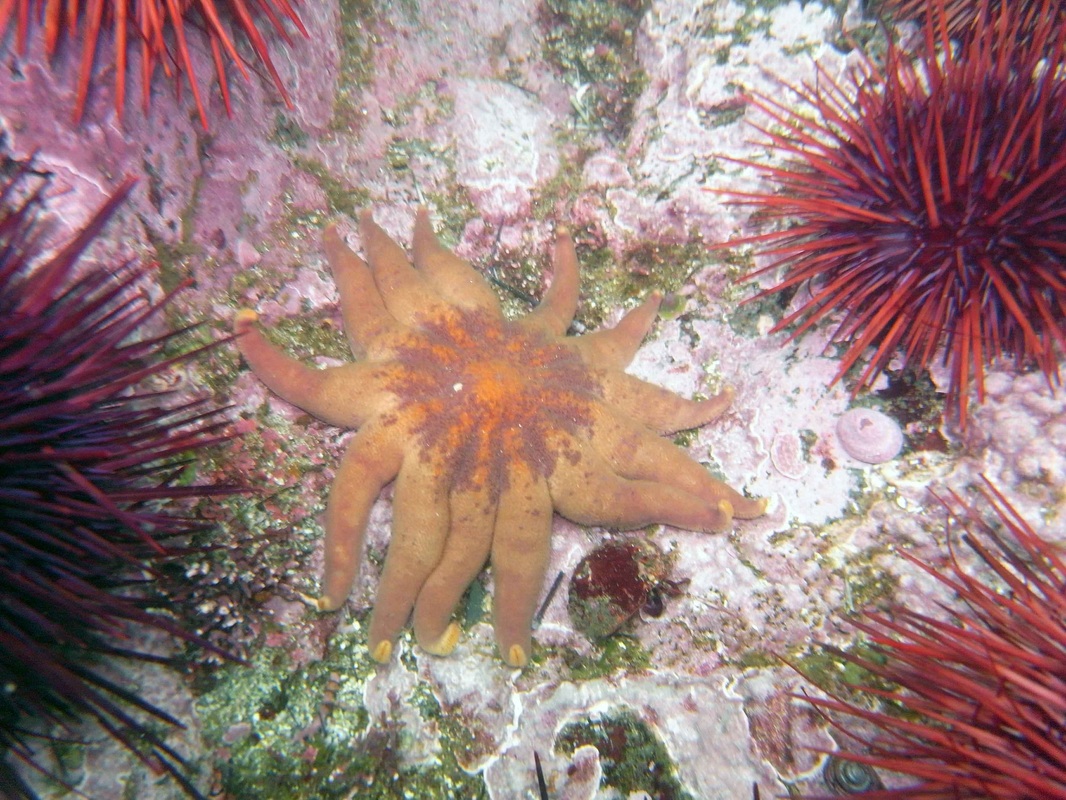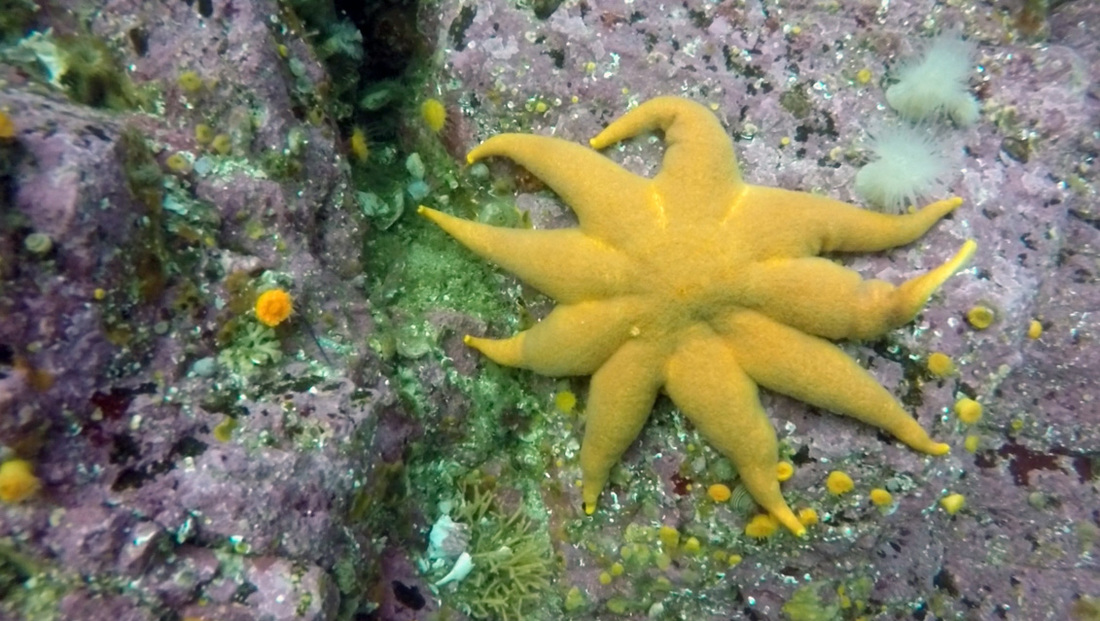Northern sunstar • Solaster endeca
Identification
This sea star has a wide central disc and a puffy appearance, with 9 or 10 short, thick, sharply-tapered arms and creases at the "armpits". It has a rough texture and is usually a shade of reddish-orange above with beige or yellow below, though its colour can vary to dark cream or pinkish-purple. It occasionally has a purple stripe down each arm or purple arm tips, and its arm tips are often curled up. The northern sun star measures up to 40 cm across, though it is commonly smaller.
Habitat & Range
The northern sun star inhabits the intertidal and subtidal to 475 m deep. It is usually found in rocky habitats in shallower water, and on cobble or mud in deeper water. This uncommon sea star has a circumboreal range. In the Pacific Ocean its range extends from the Arctic Ocean south to Puget Sound in northern Washington; in the North Atlantic it extends to Cape Cod and Great Britain.
Similar Species
The northern sunstar has a puffy, inflated appearance when compared to the similar morning sunstar (Solaster dawsoni), which lacks the "armpit" creases of the former species. The morning sunstar also has a smoother texture. On the uncommon occasion a northern sun star has a purple stripe down each arm, like the striped sunstar (S. stimpsoni), pay attention to arm length in relation to the central disc: those of the striped sunstar are much longer than those of the northern sunstar.
Intriguing Info
The northern sunstar preys on multiple sea cucumber species. It often hosts the scale worm Arctonoe vittata in a commensal relationship.
This sea star has a wide central disc and a puffy appearance, with 9 or 10 short, thick, sharply-tapered arms and creases at the "armpits". It has a rough texture and is usually a shade of reddish-orange above with beige or yellow below, though its colour can vary to dark cream or pinkish-purple. It occasionally has a purple stripe down each arm or purple arm tips, and its arm tips are often curled up. The northern sun star measures up to 40 cm across, though it is commonly smaller.
Habitat & Range
The northern sun star inhabits the intertidal and subtidal to 475 m deep. It is usually found in rocky habitats in shallower water, and on cobble or mud in deeper water. This uncommon sea star has a circumboreal range. In the Pacific Ocean its range extends from the Arctic Ocean south to Puget Sound in northern Washington; in the North Atlantic it extends to Cape Cod and Great Britain.
Similar Species
The northern sunstar has a puffy, inflated appearance when compared to the similar morning sunstar (Solaster dawsoni), which lacks the "armpit" creases of the former species. The morning sunstar also has a smoother texture. On the uncommon occasion a northern sun star has a purple stripe down each arm, like the striped sunstar (S. stimpsoni), pay attention to arm length in relation to the central disc: those of the striped sunstar are much longer than those of the northern sunstar.
Intriguing Info
The northern sunstar preys on multiple sea cucumber species. It often hosts the scale worm Arctonoe vittata in a commensal relationship.
References
Lamb, A., and Hanby, B. (2005). Marine Life of the Pacific Northwest [electronic version]. Madeira Park, BC: Harbour Publishing.
Lambert, P. (2000). Solaster endeca (Linnaeus, 1771). In Klinkenberg, Brian. (Ed.) E-Fauna BC: Electronic Atlas of the Fauna of British Columbia. Lab for Advanced Spatial Analysis, Department of Geography, University of British Columbia, Vancouver. Accessed 25/05/2016.
Picton, B.E. & Morrow, C.C. (2016). Solaster endeca (Linnaeus, 1771). Encyclopedia of Marine Life of Britain and Ireland. Accessed 25/05/2016.
Authors and editors of page
Kelly Fretwell (2016).
Lamb, A., and Hanby, B. (2005). Marine Life of the Pacific Northwest [electronic version]. Madeira Park, BC: Harbour Publishing.
Lambert, P. (2000). Solaster endeca (Linnaeus, 1771). In Klinkenberg, Brian. (Ed.) E-Fauna BC: Electronic Atlas of the Fauna of British Columbia. Lab for Advanced Spatial Analysis, Department of Geography, University of British Columbia, Vancouver. Accessed 25/05/2016.
Picton, B.E. & Morrow, C.C. (2016). Solaster endeca (Linnaeus, 1771). Encyclopedia of Marine Life of Britain and Ireland. Accessed 25/05/2016.
Authors and editors of page
Kelly Fretwell (2016).





